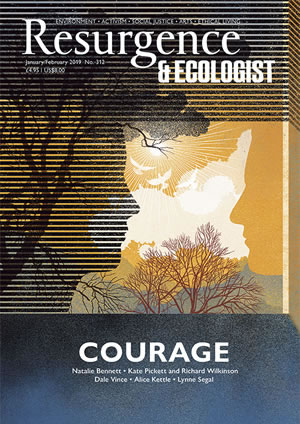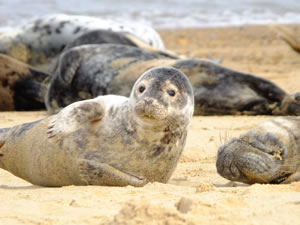Ice, plunging temperatures and harsh winds – it doesn’t seem like the right time for vulnerable, soft new life. My daughter was born at this time of year, in the midst of a big freeze. My dad, a farmer, had been on standby in case I needed a tractor to get me through the deep snow to hospital. Luckily, the roads thawed just in time for her arrival.
Now she is seven and my companion, along with her older brother, on our yearly pilgrimage to Horsey. Together we battle the coastal wind to climb the dunes, along with crowds of other people. We are rewarded with our favourite Nature spectacle: hundreds of grey seal pups and their parents on the beach.
Every year, the seals come here to give birth. It’s known as a rookery, but having experienced the heavy, ungainly feel of late pregnancy myself, I prefer the other descriptive term: a haul-out. About half the world’s population of grey seals are found around Britain, and this site is really important.
It’s got cute factor, with the fluffy white pups rolling over and seeming to wave at us with a flipper, their dark, liquid eyes like pools of innocence. Their perfect, white fur is a reminder that they evolved thousands of years ago and would originally have been born in a colder climate, onto snow.
There is plenty of humour here as well, with the comical lolloping of the adults, flopping themselves onto the sand with clumsy movements, but there is sadness too, as we notice the carcass of a pup. I think the children enjoy it best of all when the male bulls fight, bumping each other with their blubbery chests and making strange barking grunts. It’s a scene that gets recreated in my living room for weeks afterwards.
The males are vying for a space nearest the females, for soon after the pups are weaned it will be the mating season. Any pup who gets in the way of a bull could be injured or killed.
It seems like a peculiar time of year to bring babies into the world, but after a summer of feasting on fish the mothers should be in peak condition for the challenges of rearing their young. They need to be. The milk they produce is so rich – containing 60% fat – that a mother can lose over 50kg in weight in the few weeks she feeds her pup. Meanwhile, the pups can put on 2kg each day, building the thick layer of blubber they require for survival in the winter sea.
After the pups are weaned, the mothers return to the waves and leave them on the beach. This often causes well-meaning members of the public to panic that they have been abandoned. The pups still have a bit of growing up to do before they can take to the water. In three weeks or so, that fluffy white fur will moult, turning mottled grey and, crucially, waterproof.
Then the pups can head for the sea and learn to catch food. Mind you, it’s tough out there. The Friends of Horsey Seals report that more than half of the pups born won’t make it through their first year.
The seals need our protection, while on land and at sea. However adorable they look, we must keep our distance, with dogs strictly on leads. This beach operates a voluntary closure for the haul-out season, with appropriate viewing areas. We can think about marine life as a whole too, by reducing our plastic consumption, helping with beach litter picks and using marine-safe washing detergent.
Thankful for that blast of fresh air, cuteness and pure natural wonder, we head back to the warmth of home. We’ll be back to visit the seals next year.








